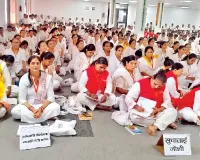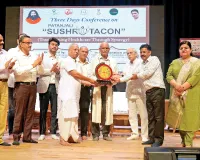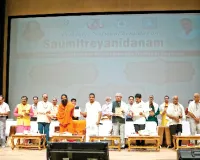Fundamental Elements of Bharatiya Sanskriti
On

Professor Rameshwar Mishra Pankaj
Here its real meaning is comprehensive culture which if followed by most people in the world but in modern time the word of English called culture is used as a synonym of the Sanskrit word Sanskriti but their real meanings are totally different. It has been said in Vedas that in the whole world there is only one Sect of the human being which is called Manava. It is quite natural that due to difference found at different places or changing time or the culture of knowledge and lifestyle can bring certain changes among same kind of people but the fundamental thing which are the basic duties accepted in the whole world for all the human beings which e nsures their progress otherwise they will not remain as a human being but they will become a demon.
In the modern European sense culture which is considered to be the synonym of Indian word Sanskriti has been a humanitarian concept and in the foundation of that concept it lies that there could be many species of human beings but all these species have a kind of uniformity of which Europeans are superior. It has also been announced that European have to study about the other species of the world and they also have a responsibility to guide the whole world this is anthropology on the basis of which distinct societies, tribes their customs there laws the Treasure of knowledge their moral values are to be studied to know about the shape of their culture and then it is presented which is called to be the culture of a society and it is presented and by knowing the specialities of India the anthropologists have a specially focused on Indian culture and their conclusion is taught and propagated as Indian culture and in this sense Sanskriti means sectarian personality on national personality and modern anthropologists have described the sectarian personality in a very strange and deformed manner while in the vedic senses Sanskriti comprise is good conduct the conduct of great Scholars and knowledge and deviation from it is called deformity and if in vedic Times Indian culture if taken up for consideration then in the same sense its deformity must be taken for consideration as well whereas in the studies of anthropology they consider deformities as culture also but in fact in this fundamental Samsung the nearest word for defining the meaning of Sanskriti is Dharma which symbolises characteristics speciality and tendencies of a society and it is in fact called the Sanskriti of the concerned society which is very correct in its meaning as the fundamental element of Indian Culture or Bhartiya Sanskriti has been Sanatan Vaidik Dharm and its basic elements.
When half of India was being ruled by the British and people from affluent families went to England to study at Christian Educational Institutes, it was only then when people by mistake started to call Islam and Christianity as a Dharma. However today things have got changed and even in modern English dictionaries the meaning of Dharma is described as the universal rules of the nature and religion means the faith propagated by some prophets. And now no educated person you will find to be saying that Dharma and religion both are same therefore we should try to understand the fundamental elements of Indian Sanskriti in this context because in Vedas we find mention of Pratham Dharma and Sanatan Dharma while in the Buddhist literature we find the mention of Rishi Dhama therefore the Dharma of Indian society is the culture of India.
In this context it is important to pay attention to the fact that we find Manav Dharma or the duty of humans only in Indian scriptures and other religions scriptures describe the glory of their practices but they fail to say a common characteristics of the followers of those regions. It is also important to note that other religions try to discriminate the people of other faiths from the people of their own faiths and this way that try to divide the human beings. Like Muslims discriminate as Momin and kafir and Christians discriminate as faithful and hidden. This way they don't see any common characteristics of all human beings while in the modern European science studies are done on human beings by considering that all humans have same characteristics therefore Christianity conflicts with science while in Indian Sanskriti fundamental element gives us the knowledge of the same duty of all humans according to which all humans are of the same characteristics and they have equal duties to be pursued and they have to follow the same rules which is called Manav Dharma or Samajik Dharma.
The duty which applies to every individual in this universe is called general Dharma or Samajik Dharma and according to Manusmriti non violence, truth ,, freedom from greed, sacredness, self-restrain are universal Dharma for all humans and according to Vishnu Dharma Shastra forgiveness, truth , lack of greed, sacredness, sacrifice, self-restrain, non-violence, compassion , selflessness, innocence, victory over envy, are the Samanya Dharma or general rules for all individuals while according to Shanti Parva of Mahabharata speaking truth, avoiding anger , forgiveness , giving birth to a child from own wife, sacredness , lack of anger, justice, taking care of people under you are nine common Dharma. Besides there are some specific Dharma according to the specialities of an individual which depends upon the position in the society, business activities, talent, capabilities, area of working, nature, self resolve. For example if you have resolved that this morning you will do certain things like you will give donations you will perform Yagya if you will serve people you will show compassion then this becomes with your self resolve your specific dharma. Varna Dharm , Ashram Dharm, Raj Dharm, Guru Dharm, Chhatra Dharm, are Dharma and every individual has got certain social and spiritual duties which are their Swadharma which includes both general and specific Dharma. In Yoga Darshan it has been said that non violence truth lack of greed celibacy and aparigraha are five universal Yama, which are to be followed by everybody and according to specific position some people have specific profession which is decided by their Jati or presence in some specific country or some specific time which might have some limitations.
In the context of Dharma yoga Darshan throws specific light on it as in the Vyas bhashya of yog Sutra the first sentence says-
Yogyatavachchhinna Dharminah Shaktih Aeva Dharmah.
The capability is based on a person's abilities is something that decides his Dharma for example burning is the characteristics or duty of Fire , similarly a person who donates and donation will be his Dharma , similarly the duty of a student is to learn and the duty of a student is to teach, so these are there Dharma that means something that recognises every individual with his duty or Dharma and in the language of yoga or we may say we can say that the wisdom aspect of a matter is its Dharma that means that makes its presence felt is its Dhama and the same way these are the three basic Dharma of yog Darshan- which are Prakash or light, action or Karya, Inertia or Jadta. Similarly three basic Dharma are Abhyantar- which are Gyan, Kriyashilta and Dhriti.
What should be done when and what should not be done this can be understood by the sense of Dharma which can be achieved by the means of knowledge.
The first wisdom that develops in a person through scriptures and their studies and later on proper contemplation makes the knowledge stronger and more clear and wisdom that becomes strong it is called Gyan Deep that means this way Vivek Sadhana comes only through self restraint and capable person can make it possible.
The Mind which has prominence of good qualities or Sattva Guna it has been described in Shrimad Bhagwat Geeta and the wisdom which knows the distinction between duty and what should not be done, feared things and the things that should not be feared, getting trapped in life cycle and salvation only that wisdom or mind is called Satva Pradhan Buddhi and similarly Satvik Gyan that is the pure knowledge is that which considers all living beings ngondestroy bill conscious and Supreme Power and see them with a view of equality and this is possible only by the means of nonviolence and purity of inner self with the view of equality only that has the wisdom of nonviolence and purity of inner self for him this is possible.
The definition of non violence is that when you don't have any feeling of violence or hurting to don't hurt any of the living being always and if you think that you don't hurt any living being, only that is not non violence but non violence is the idea which expands to the whole nature , environment and all living beings to what would you have to have a feeling of friendship, compassion and softness of the heart only then you can say that you are following the path of non violence.
Here the question arises that what is checked the Bhumi and according to Yog Darshana Driksha , Atmasatta, Chaitanya Roop, are something that define it and by the means of this Chaitanya you can arouse your mind and you can enlighten all the the things and something that it is a delight that is something that can be spelt or changed by the means of its for juice smell touch are the complete expansion and you can have their knowledge.
Knowledge activities position and the strength to follow the path of Dharma that is this Dhritishakti are in fact Chita of Antahkarana. Chita means all the the senses and in Yoga Darshana they are also called Pratyay and Pratayaya Chita define Dharma besides it also contains Sanskar in invisible form. It can also be defined that the innerself which has prepared and Sanskar are together is called Chita and it can be identified as its tendencies and when one is engrossed in tendency is then we can say that it is in the position of chtta.
In yogdarshan five types of Chitta vritti having classified - Chitta vritti can also be called Buddhivritti and Viparyaya that means the sense of reality with that means the understanding of something that is not reality and Vikalp that means that is different from all the things and that creates illusion and Smriti that means the feeling of of experience that is the understanding of sleep.
It is worth mentioning that one should not consider Mana and Chita as same things because Mana is Sankalp indriya and Gyanendriya and karmendriya have their Abhiyantarikh Kendra and our mind absorbs the things or contains the things they have tendencies and the thing that maintains its sense is called Shakti Chita.
Four purusharth of human life
There are R4 purusharth of human life which are Dharma Artha Kama Moksha and three of them are are achieved inlife which means they are social purushartha for World early activities and forth is personal or spiritual which is Supreme and here the basic meaning of Supreme is not the main but it is away from all others that is Moksha which is not the goal of social life. It is absolute Purushartha and here the meaning of a solute is something of Paramount importance and salvation or Moksha are not the goals of life but it is something which describes the goals of life and makes everything of life visible which means Param purusharth therefore the way a person cannot be successful in all walks of life however every individual has got the righ to make efforts to become the most successful which can lead to the utmost duty. Moksh is not the Samanya Dharma or general duty of a human being but it is specific Dharma or specific duty.
It has been clearly set in Manusmriti that there are three purushartha of a an individual Dharma Artha and Kama and in fact Moksh is not counted among the three as it is specific Dharma as it has been described in Manusmriti.
Dharmarthauvuchyate Shreyah, Kamarthau Dharma Aeva Cha l
Artha Aeveha Va Shreyah, Trivarga Iti Tu Sthitah II
(Some are of the view that Dharma and Artha have Shreyakar Sadhana or proper means while some others are of the view that Kama and arth are like this while some more people think that only Dharma is like this and the right position is that Dharm Arth and Kama all these three are trivarg shreyaskar. )
Manusmriti clearly says that all the three Rin or Debts like Dev Run, Rishi Rin and Pitri Rin are three duties of every individual and after being free from them our main focus has to be on attaining Moksha (Rinani Trini Apakrityo Mano Mokshe Niveshyet) l Those who try to get Moksha without getting free from the three debts they go in Adholok. It is quite clear that those who have in their mind to rise above the responsibilities of a family life only they can try to get Moksha or salvation. Manu has said- by giving everything as donation and becoming a hermit and giving a fearless life to all individuals and all living beings one who leaives home only he can get divinity.
Dharm, Arth and Kaam
This way trivarg is considered to be a common Dharma and Mokshadhama is considered to be very specific which is amalgamation of all purushartha which is in fact the end. This way Dharma has a very comprehensive meaning or very specific meaning and in this context whatever duties are, all of them are Dharma therefore Kaam and Artha which should be done are Dharma to that extent therefore our goal in this life has to be kama and Artha only to the extent when they are associated with Dharma. Lord Krishna has said in Geeta- Dharmaviruddho Bhuteshu Kamesmi Bharatarshabha l I am the Dharma Avirodhi Kaam in all living beings.
Form of Yagya meaning
To understand the Indian outlook of Dharma, Artha, Kama and Moksha it is important to understand Srishti Chakra or Yagya . Rigved calls Yagya as Bhuvanasya Nabhi. It has been said in Purushasuktya - Veda and all the things in the universe have come out of Sarvahut Yagya. In Brahmin scriptures we get description of most of the Yagyas and in these bramhan scriptures, shatpath Brahman we find the description and a very comprehensive detailed mention of it and they also give a very clear description of Yagya.
This universe is not dependent only on human forces but human forces are just a part of the universe process and its overall power is very huge and great and they are divine powers in fact. This universe is creation of those divine powers therefore humans are also the result of the same divine powers and the same divine powers are also the power of demons. There is not any big difference between divinity and demon power and they are not conflicting in a great way. The power guided by Rit and truth is divinity and when this power breaches its limits then it becomes demonic. Both are same forces but due to difference in discipline and their characteristic becomes different.
(To continue...)
लेखक
Related Posts
Latest News
01 Dec 2024 18:59:48
योग प्रज्ञा योग - योग जीवन का प्रयोजन, उपयोगिता, उपलब्धि, साधन-साधना-साध्य, सिद्धान्त, कत्र्तव्य, मंतव्य, गंतव्य, लक्ष्य, संकल्प, सिद्धि, कर्म धर्म,...








.jpg)
.jpg)






.jpg)


1.jpg)
.jpg)
